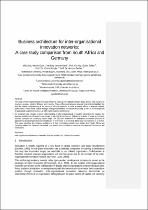 ResearchSpace
ResearchSpace
Business architecture for inter-organisational innovation networks: A case study comparison from South Africa and Germany
JavaScript is disabled for your browser. Some features of this site may not work without it.
- ResearchSpace
- →
- Research Publications/Outputs
- →
- Conference Publications
- →
- View Item
| dc.contributor.author |
Gous, H

|
|
| dc.contributor.author |
Gard, J

|
|
| dc.contributor.author |
Baltes, G

|
|
| dc.contributor.author |
Schutte, C

|
|
| dc.contributor.author |
Gerber, A

|
|
| dc.date.accessioned | 2012-02-13T14:49:46Z | |
| dc.date.available | 2012-02-13T14:49:46Z | |
| dc.date.issued | 2011-06 | |
| dc.identifier.citation | Gous, H, Gard, J, Baltes, G et al. Business architecture for inter-organisational innovation networks: A case study comparison from South Africa and Germany. 17th International Conference on Concurrent Enterprising (ICE), Germany, 20-22 June 2011 | en_US |
| dc.identifier.isbn | 978-3-943024-05-0 | |
| dc.identifier.uri | http://ieeexplore.ieee.org/xpl/freeabs_all.jsp?arnumber=6041244 | |
| dc.identifier.uri | http://hdl.handle.net/10204/5563 | |
| dc.description | This is the post-print version of the work. © 2011 IEEE. Reprinted, with permission, from Gous, H, Gard, J, Baltes, G et al. Business architecture for inter-organisational innovation networks: A case study comparison from South Africa and Germany. 17th International Conference on Concurrent Enterprising (ICE), Germany, 20-22 June 2011. This material is posted here with permission of the IEEE. Such permission of the IEEE does not in any way imply IEEE endorsement of any of CSIR Information Services' products or services. Internal or personal use of this material is permitted. However, permission to reprint/republish this material for advertising or promotional purposes or for creating new collective works for resale or redistribution must be obtained from the IEEE by writing to pubs-permissions@ieee.org. By choosing to view this document, you agree to all provisions of the copyright laws protecting it. | en_US |
| dc.description.abstract | The range of inter-organisational innovation networks existing in the global economy today show a wide variance in structure, purpose, location, lifespan and maturity. These differences between network instantiations highlight the need for deeper understanding of the operation of these networks in order to enable efforts to improve network performance. These efforts include strategic management routines for network leadership, as well as the development of appropriate support structures, e.g. information systems architectures. An important step towards a deeper understanding of inter-organisational innovation networks is to compare the business architectures of network case studies to identify similarities and differences in terms of scope and context, business concepts and underlying system logic. The Zachman framework for enterprise architecture provides an approach to structuring the business architecture of enterprises in a way that allows such comparisons to be drawn. This paper describes the business architecture of two contrasting network case studies from South Africa and Germany within the Zachman framework, and draws some conclusions based on the observed similarities and conclusions. | en_US |
| dc.language.iso | en | en_US |
| dc.publisher | IEEE | en_US |
| dc.relation.ispartofseries | Workflow;8067 | |
| dc.subject | Inter-organisational innovation networks | en_US |
| dc.subject | Business architecture | en_US |
| dc.subject | Zachman framework | en_US |
| dc.title | Business architecture for inter-organisational innovation networks: A case study comparison from South Africa and Germany | en_US |
| dc.type | Conference Presentation | en_US |
| dc.identifier.apacitation | Gous, H., Gard, J., Baltes, G., Schutte, C., & Gerber, A. (2011). Business architecture for inter-organisational innovation networks: A case study comparison from South Africa and Germany. IEEE. http://hdl.handle.net/10204/5563 | en_ZA |
| dc.identifier.chicagocitation | Gous, H, J Gard, G Baltes, C Schutte, and A Gerber. "Business architecture for inter-organisational innovation networks: A case study comparison from South Africa and Germany." (2011): http://hdl.handle.net/10204/5563 | en_ZA |
| dc.identifier.vancouvercitation | Gous H, Gard J, Baltes G, Schutte C, Gerber A, Business architecture for inter-organisational innovation networks: A case study comparison from South Africa and Germany; IEEE; 2011. http://hdl.handle.net/10204/5563 . | en_ZA |
| dc.identifier.ris | TY - Conference Presentation AU - Gous, H AU - Gard, J AU - Baltes, G AU - Schutte, C AU - Gerber, A AB - The range of inter-organisational innovation networks existing in the global economy today show a wide variance in structure, purpose, location, lifespan and maturity. These differences between network instantiations highlight the need for deeper understanding of the operation of these networks in order to enable efforts to improve network performance. These efforts include strategic management routines for network leadership, as well as the development of appropriate support structures, e.g. information systems architectures. An important step towards a deeper understanding of inter-organisational innovation networks is to compare the business architectures of network case studies to identify similarities and differences in terms of scope and context, business concepts and underlying system logic. The Zachman framework for enterprise architecture provides an approach to structuring the business architecture of enterprises in a way that allows such comparisons to be drawn. This paper describes the business architecture of two contrasting network case studies from South Africa and Germany within the Zachman framework, and draws some conclusions based on the observed similarities and conclusions. DA - 2011-06 DB - ResearchSpace DP - CSIR KW - Inter-organisational innovation networks KW - Business architecture KW - Zachman framework LK - https://researchspace.csir.co.za PY - 2011 SM - 978-3-943024-05-0 T1 - Business architecture for inter-organisational innovation networks: A case study comparison from South Africa and Germany TI - Business architecture for inter-organisational innovation networks: A case study comparison from South Africa and Germany UR - http://hdl.handle.net/10204/5563 ER - | en_ZA |





